 |
| Saijou Inari 最上稲荷神社 - vermilion torii |
The first thing I'd like to tell you is that the place even though it was in Kurashiki, it was a bit outside of the actual city. We had to use to GPS to get there and to be honest with you at this very point I don't even know how we managed to get there since the GPS was giving us the wrong directions.
This temple/shrine was recommended by my friend's mother, who knew how much I love nature and Japanese shrines. However, my friend had never been there before so we had to drive here and there (even with the use of GPS).
View Larger Map
If you ever had the chance to get lost in Japan with a car "do it" because you won't regret it. I reckon it is like any other country you visit, you get to see more if you rent a car and go out on the countryside.
One thing is that I knew that we were going to the mountains however how close where these mountains from Kurashiki, that was to be seen. It was all flat when all of a sudden we started seeing these mountains far in the distance. They were getting closer, or rather we were getting closer to them as we were driving towards them.
Finally we arrived at the temple and here's the part of the trip I didn't expect. We got there and the first thing we saw was a food shop opened but not very crowded. I told my friend lets leave it for the way back so we carried on and it seems that this temple is very popular because there was a mini market that was empty since there were NYE holidays and almost anything was opened. We passed the empty shopping corner and finally we arrived at the temple's entrance guarded by two big Buddhist gods and a typical Indian Buddhist stone site.
 |
| saijou inari 最上稲荷神社 - Buddhist temple |
We took some pictures and then walk upstairs to et to the main temple, but instead what we found was he temple and also another shop, a souvenir shop.
We both had to go quickly go to toilet so afterwards we visited the shop.
I don't know if I have mentioned this before but every Shinto or Buddhist temple has always a shop outside that sells blessed amulets or blessed wooden bills that you are supposed to write and hang them outside the shrine.
Although, buying Ema or wooden little tables to write is more of a Shinto thing.
They also had many things but one thing took me aback and it was a empty space with nothing but this funny toy with a sad face. I thought the message said something important but not close.
 |
| Woodcraft - Buddhist Temple -Saijou Inari 最上稲荷神社 |
We didn't but anything since according to my friend we had to carried it and we were going to walk ( trek) for a bit. I didn't know anything yet and at that point I said, well this is a very small temple with nothing much to see.
I was so wrong!
As we walked inside the temple and went out we got behind the temple and a beautiful forest opened up in front of our eyes. Here's the first hill that you will have to climb and on the way you'll find some small Buddhist temples and right in the end you come to a different place where everything turns vermilion coloured.
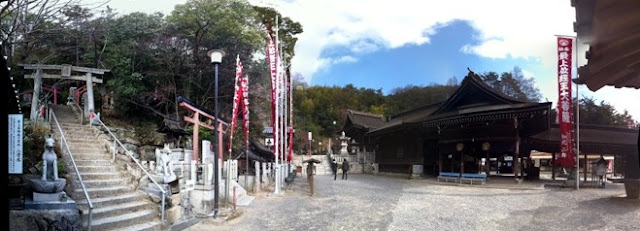 |
| saijou inari 最上稲荷神社 - mountain torii entrance |
Then I recommend you to go to the last toilet available - from then on (if you decide to go up) you won't find a toilet so you'll have to do in out in the outdoor, but since it's a sacred placed I reckon it'll be a bit disrespectful .
The shrine starts with a big torii and two kumainu or dog gods (according to my friends they are not dogs) all painted in stained vermilion. I promised I wasn't ready for this as I didn't expect to visit any mountain in Japan so this was a bonus for me. We started to climb up and all of a sudden my religious experience had a turn. The religious experience felt more like a trek rather than a Shinto experience. In Kyoto and in especially in Ise, I previously experience Shinto shrines on top of a mountain and it was nice but a weird nice feeling. This shrine was a bit different, maybe because there weren't too many visitors and everything was very peaceful.
Like I told my friend I think I could convert myself into shintoism but there's only one problem to that, well actually two: First, there aren't Shinto shrines outside Japan. Secondly, I can't see the emperor of Japan as the one of the gods. Nevertheless, I do like the idea of believing that everything in nature has a life and can potentially be a god.
 |
| mini shrine - Saijou Inari 最上稲荷神社 |
After being living in Malta for 2 years I can say I miss the trees, big trees. This shrine had everything, big trees, cats, spiders, waterfalls and "holy" fruit (nope, not an apple - that's another tale) which but I will explain about it later.
The first Shinto items we came across with we're some tiny shrines with porcelain kumainu. These mini or even micro shrines must have been built by someone with a lot of passion, but nowadays they all look deteriorated and old. However, that doesn't mean that nowadays they take good care of it as this little shrine was like I said in very bad conditions as many of the other ones we would come across along the way.
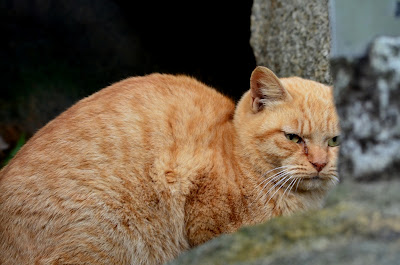 |
| angry cat - Saijou Inari 最上稲荷神社 |
As we were walking upwards we saw this cat who contrary to what people believe that Japanese cats are beautiful this one had a very sad and angry face. He or she wasn't violent towards us but it didn't want to be disturbed, that's for sure.
We kept walking and then the trees started to be bigger and with bigger branches giving us a nice shade so we could hide from the sun. Moving on, we saw this typical Japanese vermillion colour coat bridge and there was nothing really special about it, but the spiders around there, they were nice to play with as well as take a picture of.
 |
| Nephila pilipes - wood spider at the Saijou Inari 最上稲荷神社 |
The spiders had many preys wrapped in their web and they didn't move until I, stupid me, wanted to see some action so I touched the preys a bit. That tiny touch of me on the preys cause a bit vibration and the spider came quickly and used its teeth to re-kill the prey (as if ) . Yes, I know that was a bit silly but I wanted to play a bit with nature. Leaving the spiders behind and not far from the bridge were some the wooden stairs that were going to take us up to another stop on the way up.
We started to going up stairs and right on the left hand side there was this mysterious wooden platform that was like a little floating island. It also has a tiny wooden house. And right in the same place the most amazing fountain ever, a dragon fountain to honour other god of water.
 |
| dragon fountain - saijou inari 最上稲荷神社 |
It is incredible that such shrines were built up in the mountain, I like the way they mix nature and religion without making a mess of the environment or the landscape. Perhaps not everyone agrees but the way I see it, Shinto shrines are a very relaxed experience. Although Japan is not the only one, in the Chinese and Korean mountains one can find the same shrines up in the mountain.
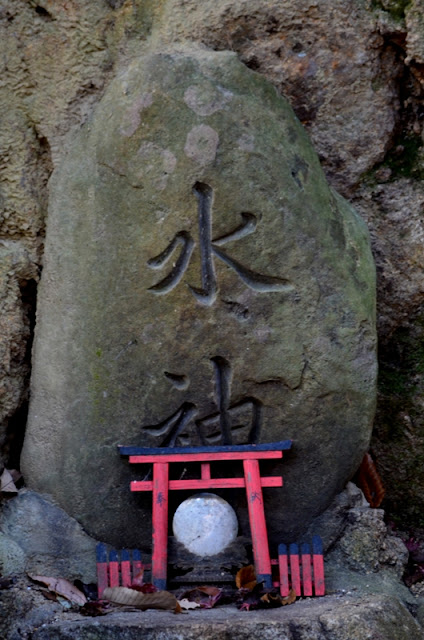 |
| water god - saijou inari - 水の神様 - 最上稲荷神社 |
After the dragon fountain we kept going upwards and i saw this carved stone with the 4 cardinal points. I didn't know the name of north, south, east and west but my friend explained them to me clearly.
At this point, we looked up and the amount of stairs we had to walk up didn't look easy, it reminded me Seinto Seya for one reason, but that was part of the trek or religious experience.
We were walking up and then we saw another shrine that happened to be a bit bigger than the rest of the shrines we had seen till then. This one had a massive stone wall and one can find big Buddhist writings that were carved on the stones alonf the site. Mystery to me, is that even though it is a Shinto praying site it has a lot of Buddhist writings. And I dare to say they were Buddhist because I have only seen that type of carving on a stone in Buddhist temples and also because my friend told me.
 |
| Carved Stone - 最上稲荷神社 |
As we left that place and we climbed up a bit more we came to the top and we had this great panoramic view of Kurashiki, although a landfill site spoiled the landscape.
 |
| Okayama Panoramic from saijou inari 最上稲荷神社 |
From there we could see Okoyama and Kurashiki behind the mountains with a deep dark green colour of the pinetrees, that form this ilussion of green carpet way away from us. However, this beautiful landscape was spoiled by a big cloud of pollution that wrapped the cities nearby. It was not as bad as in China but i reckon in a couple of years or perhaps within a decade the landscape in Japan won't be that different ( I really hope I'm wrong on this one). Although that can change if politicians and big companies work together hand in hand.
As we walked around on the top of the mountain we saw these trees with plenty of orange coloured fruits. My friend told me not to eat them since they belonged to the mountain, but I really wanted some of them. Even the young people who happened to also be on the top (crowdest place of the trip - perhaps 10 people in total) didn't take any of the fruits that were easy to pick. That made me think that in any other country young and old people wouldn't care about this and they'll get some and eat them straight away. Certainly not the case over here on the other side of the world.
Once we've walked around the top and taken lots of pictures, we saw that the path carried on until a point where it split in two and we took one of them. She didn't know where we were going but soon we were going to be find out.
The path carried on and now we were walking downhill and by then there was no doubt that today it was a nature day. Somehow, we didn't find any religious sign on the way. The downhill took us some 25 minutes so it wasn't that bad and finally we saw an entrance to what seemed to be an isolated and hidden Buddhist site.
First the white Buddhist entrance and then on the right there was a lake which we thought it was small. It wasn't but we found out later on that the lake surrounds a holy site.
View Larger Map
The first thing we saw was a portion of land with lots of tiny stone buddhas perfectly aligned all overlooking the lake. Why would they place little Buddha statutes here in the middle of nowhere? Nobody knows, but that place looks like a good place to meditate and think about life without being disturbed.
Across the road there another wooden house surrounded by tiny old wooden houses and lots of kumainu or foxes made of porcelain around them.
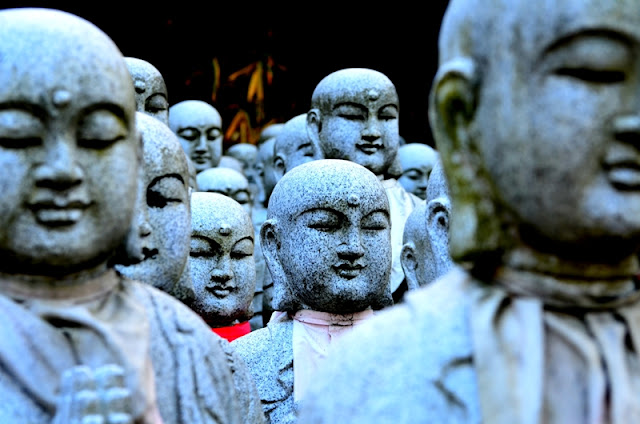 |
| buddha army - saijou inari 最上稲荷神社 |
We carried on and finally civilisation came to us, a car passed by, but as it passed near to us it quickly vanished among the pine trees, it entered a deep forest and we never saw it again.
THe lake was on the right hand site and we tried to see if there were fish and there were plenty of them, but nobody was fishing and the lake was big enough to have plenty of little boats. By some strange reason, this part was almost isolated from everything (despite, hearing planes on top of us every now and then). As we kept walking we came to another Shinto shrine and this time one big torii was facing the lake, we guess is that the big lake itself was a kami or god and hence there were no boats or anybody was fishing - surreal.
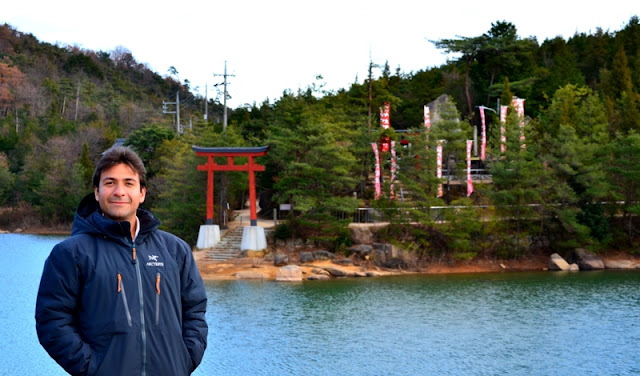 |
| saijou inari 最上稲荷神社 - Torii Lake entrance |
When we reached that part of the lake we were a bit tired so we didn't go up to that hilly shrine to see who the god was. But I didn't let me friend (upps..) resting a bit and we walk another half kilometre to go around the lake and see if there was anything else.
What do you think? Yes indeed there was more to see but it was like a dream, because I think the whole site was man made. We walked around the lake and we were now on the other side and we were walking on a grassy path but on the other side there was a hill going down.
Some 100 metres away there were two other Buddhist temples with lots of flags. I will never know what it was but it looked like a fortress hidden and surrounded by mountains, we will never know was it was (perhaps in the future) but it looked a bit weird.
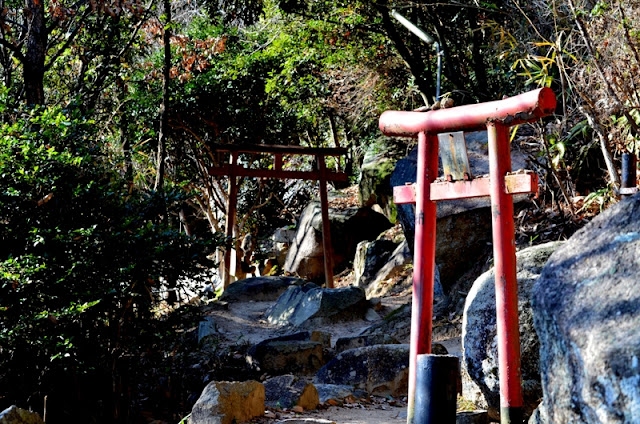 |
| torii in saijo inari - 鳥居の最上稲荷神社 |
Finally, my friend said, "ok Jorge let's go back" so against my will - I'm joking here - as I was also tired and hungry as a wolf - we headed back and I breathed in once last time the pure air.
The way back took us less but it was a bit hard to do in one go without taking a breath every now and then. However, it was late and we had to go back home soon before it started to get dark.
I won't tell you what happen on the back because nothing happened until we got to the main entrance to the temple.
We rushed inside the shop to buy some drinks and some typical sweets from the place. Obviously, the sales assistants hadn't seen any foreigners before or at least that was my impression. They asked my friend where we were coming from and where I was from. They couldn't believe it but that made them all happy, and even though it was closing time they showed me the best they had to offer. I was very hungry but here I was going to buy the best chestnuts I have ever tried in my life.
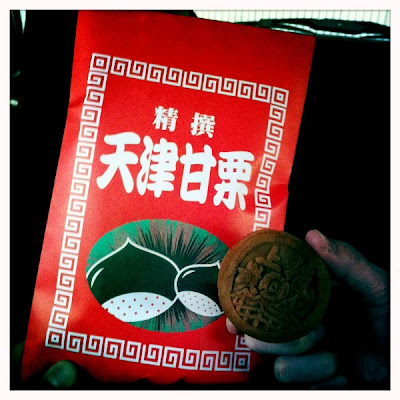 |
| Japanese chestnuts - saijou inari 最上稲荷神社 |
Funny thing is I wasn't going to open those chestnut until three months later when I took them with me to Venezuela when I when to visit my family.
Wait did you take put food from Japan? Are you mad? - I'm sure you might be wondering about the radiation problem. Well perhaps people would freak out a lot so I told them that they had a anti-radiation seal ready-to-eat pack.
Whatever, not really they just guaranteed that the food was safe, but the important thing was that the flavour was great. The Japanese chestnuts are tiny compared to the European ones but, they are lighter and you can eat as much as you want.
When we got home it was almost time to start making all the preparations for the last day of the year. My friend's family had already prepared everything. We had a proper bath and then we sat on the table and started eating this special dish that families around Japan eat on the last day of the year.
This special dish is called osechi-ryori or 御節料理 and it has a bit of everything although it varies from region to regions as well as family customs. Let me show you how the typical osechi plate looks like.
 |
| Osechi-ryori-pickles-shrimps-egg |
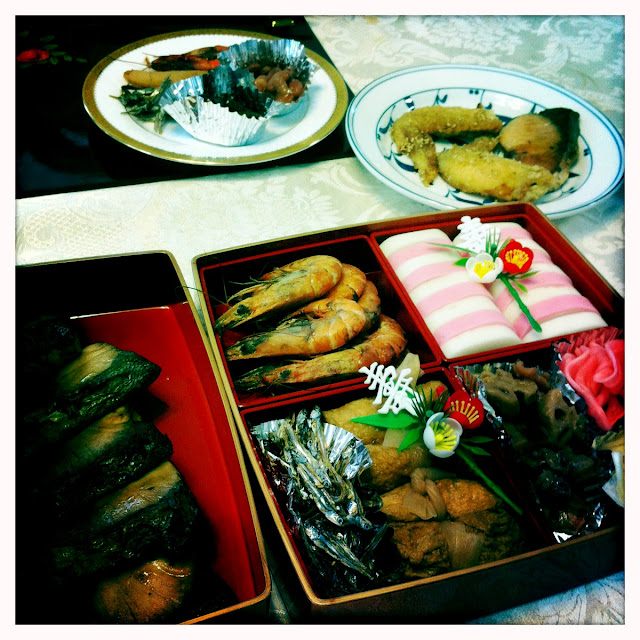 |
| Osechi - Buri - Shrimps - Dried fish - pickels |
I'm also including a new picture of the fish my friend's family and I ate that day. It's called buri 鰤 and its taste is very soft but fat in the end. Buri is a fish eaten normally during the cold months and since it was NYE and a cold time this fish came perfectly.
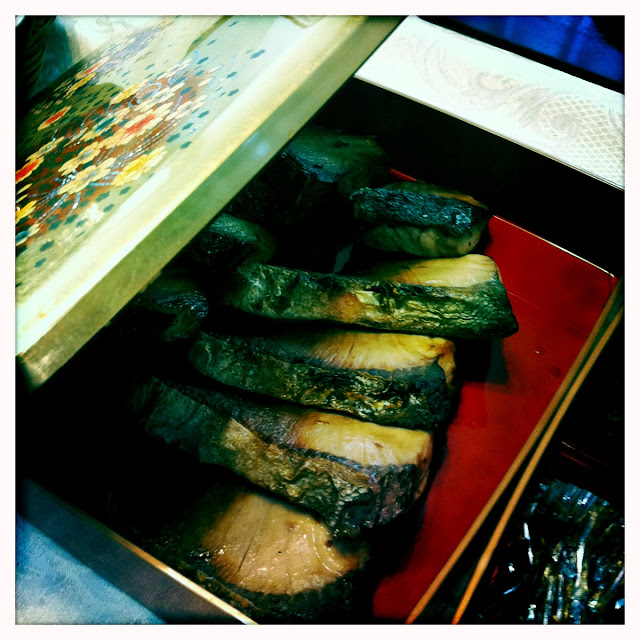 |
| Buri - 鰤 or yellow tail fish |
The last day of the year in Japan, especially the last hours of the year are a bit different to what I had imagined and to be honest I didn't have a clue of what was going to happen. I was expecting fireworks but everything was very quiet. Instead, my friend told me that Japanese families normally stay at home and towards the end (an hour before new year ) people go to shrines or temples to hear the first dong made by the big bell in the temples (normally the buddhist).
However, the last day of the year even though the family is together they don't wait for everyone to come home and enjoy the food together. They eat whenever they want, perhaps it was my friend's family, I don't know.
During or after eating osechi you have this funny TV programmes where they show, really hilarious programmes (mind you - you don't need to understand Japanese to get the jokes but it helps) One of those programmes is this one, which name I can't remember one.
No comments:
Post a Comment